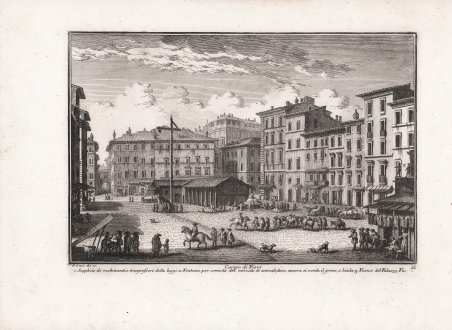Veduta tratta dalla monumentale opera ' Delle magnificenze di Roma antica e moderna. Pubblicata in 10 volumi dal 1747 al 1761, l’opera presenta 238 incisioni in rame, ciascuna incisione con testo narrativo che fornisce informazioni storiche e documentarie. ' Conosciuto dai più semplicemente come il "maestro" di Giovanni Battista Piranesi, Giuseppe Vasi rivela in quest'opera monumentale la pienezza della sua creatività grafica. I 10 libri che la compongono hanno ognuno un frontespizio con titolo e data diversi: ' Libro primo che contiene le porte e mura; Libro secondo, che contiene le piazze principali di Roma con obelischi, colonne, ed altri ornamenti; Libro terzo, che contiene le basiliche e chiese antiche di Roma; Libro quarto che contiene i palazzi e le vie più celebri; Libro quinto che contiene i ponti e gli edifizj sul Libro sesto che contiene la chiese parrocchiali; Libro settimo che contiene i conventi e case dei chierici regolari; Libro ottavo che contiene i monasteri e conservatorj di donne; Libro nono che contiene i collegj, spedali, e luoghi pii; decimo che contiene le ville e giardini più rimarchevoli. Le ' Magnificenze ' forniscono un panorama completo e al tempo stesso anticonvenzionale dell'Urbe: così, insieme alle consuete, celeberrime inquadrature desunte dalla migliore tradizione vedutistica, si trova anche una Roma insolita, quella che, talvolta, non esiste più. A quest'opera, di centrale importanza nell'editoria romana di metà Settecento, l'Autore aveva lavorato per quasi un ventennio realizzando una monumentale guida dell'Urbe dove accanto alle consuete e celeberrime inquadrature tratte dalla migliore tradizione vedutistica, immortala anche scorci insoliti che sono poi scomparsi con il cambiare della città. Il testo che accompagna le vedute nel primo volume è opera di Giuseppe Bianchini, nel secondo di Orazio Orlandi e nei restanti del Vasi stesso. Acquaforte, in ottimo stato di conservazione. Nella didascalia in basso, Vasi fa riferimento a: 1 Supplicio de malviventi, e trasgressori delle leggi - 2 Fontana per comodo del mercato di animali, dove ancora si vende il grano, e biada - 3 Fianco del Palazzo Pio This view shows one of the busiest squares of XVIIIth century Rome. It did not house an important church or a public building, but many inns, shops and street sellers of cooked food were located there or in the nearby streets. Twice a week it housed a horse and fodder market. Jacket makers had their workshops at the beginning of Via dei Giubbonari , the street which led to S. Carlo ai Catinari. Other nearby streets were named after beccai (butchers), cappellari (hat makers) and baullari (trunk makers). The gallows is a reminder that Campo dei Fiori, because of its central location, was often chosen for the public punishment of criminals, especially of heretics. It was not used to execute death penalties, but to punish lesser offences or as an instrument of torture. A rope hung from a pulley to which the culprit was tied and then he was raised and lowered to the ground several times; the street leading from Campo dei Fiori to Piazza Farnese is still called Via della Corda (Rope Street). In the description below the plate Vasi made reference to: 1) The gallows; 2) Fontana della Terrina; 3) Palazzo Pio. 3) is covered in another page. The small 1748 map shows also 4) Via del Pellegrino; 5) Albergo della Vacca. The dotted line in the small map delineates the border between Rione Regola (left lower quarter) and Rione Parione. Etching, in very good condition. View taken from the monumental work ' Delle magnificenze di Roma antica e moderna. Published in 10 volumes from 1747 to 1761, the work features 238 copper engravings, each engraving with a narrative text that provides historical and documentary information. Known by most simply as the "master" of Giovanni Battista Piranesi, Giuseppe Vasi reveals in this monumental work the fullness of his graphic creativity. The 10 books that compose it each have a title page with a different title and date: ' Libro primo che contiene le porte e mura; Libro secondo, che contiene le piazze principali di Roma con obelischi, colonne, ed altri ornamenti; Libro terzo, che contiene le basiliche e chiese antiche di Roma; Libro quarto che contiene i palazzi e le vie più celebri; Libro quinto che contiene i ponti e gli edifizj sul Libro sesto che contiene la chiese parrocchiali; Libro settimo che contiene i conventi e case dei chierici regolari; Libro ottavo che contiene i monasteri e conservatorj di donne; Libro nono che contiene i collegj, spedali, e luoghi pii; decimo che contiene le ville e giardini più rimarchevoli. ' The ' Magnificences ' provide a complete and at the same time unconventional panorama of the City: thus, together with the usual, celebrated shots taken from the best tradition of ' vedutistica, one also finds an unusual Rome, one that, at times, no longer exists. The author had worked on this work, of central importance in Roman publishing in the middle of the eighteenth century, for almost twenty years, producing a monumental guide to the “Urbe” where, alongside the usual and famous shots taken from the best tradition of ' vedutistica, he also immortalized unusual views that have since disappeared with the change of the city. The text that accompanies the views in the first volume is by Giuseppe Bianchini, in the second by Orazio Orlandi and in the remaining ones by Vasi himself. Cfr. Scalabroni, 98

Descubre cómo utilizar
Descubre cómo utilizar

